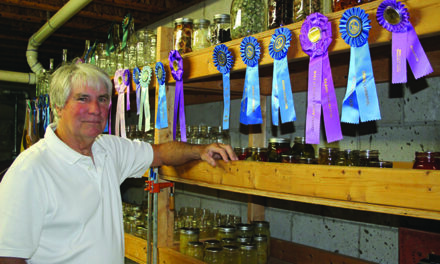
Proper planting, pruning know-how and patience are some key ingredients of espalier success. (Photo courtesy Stark Bros. Nurseries & Orchards Co.)
When apple season arrives, the dream of enjoying one’s very own apple orchard often beckons.
That dream may seem out of reach to those with downsized yards, but it doesn’t have to be.
With recent talk of food scaping, it’s worth exploring a vintage version of edible landscaping known as espalier.
This French word, meaning “to lean one’s shoulder against,” describes a time-honored practice of training trees to gracefully grow flat, up against a wall, fence, or trellis, taking up far less space.
While applied to ornamental trees such as gingko and others, the procedure was found to be especially “fruitful” for orchard production.
In espalier, a dwarf or semi-dwarf “whip” (unbranched plant shoot) is carefully pruned of all but a few essential branches and gently attached to its supporting foundation, allowing for growth and shape support.
Some say the method dates to ancient Egypt, as evidenced by tomb pictures from 1400 B.C. Relatively more recently, records from 17th century English and northern French monasteries refer to the procedure. In these cooler climates, setting the trees against a wall especially would create a warmer microclimate which was more conducive to producing fruit.
The observance became standard practice in formal European gardens, and eventually, American colonial gardens followed suit.
The Early American Gardening blog from Monticello cites regular mention of espalier among colonial correspondence.
Dean Norton, Horticulture Director at Mount Vernon, George Washington’s Virginia estate, explained that the recorded gardening wisdom of the period extolled the virtues of espalier.
Since Mt. Vernon’s restoration in 1937, the area’s upper and lower gardens have included espaliered peach, apple, pear, and apricot trees along a brick wall, and trellised apple and pear trees between vegetable rows.
Espalier is often represented by elegant classic styles including the horizontal cordon, Belgian lattice, candelabra, and fan, but there are many more possibilities for creativity once the basics are mastered.
River Road Farms in Decatur, Tenn., is a specialized nursery dedicated to the art of crafting espalier into several styles, as well as candelabra arbors and double heart shapes, from tender unbranched plant shoots known as whips.
Peter Thevenoux, River Road Farms’ founder, became an espalier devotee after visiting Mount Vernon in the 1990s.
While inspired by the artistically landscaped fruit trees there, Thevenoux’s enterprise recognizes the contribution of the French, who named the practice, and specifically a Father Legendre of Hanonsville in France, who is credited with devising a flat pyramid shaped pear tree at his monastery garden in 1684.
Nathan Roling has overseen the espalier training area at Mt. Vernon for the past four years, helping ready replacements for the classically shaped fruit trees against the upper garden brick walls (“peach, apricot, pear, apple—a little bit of everything there”) and the apple and pear trellised cordons that form rows in the lower kitchen vegetable garden.
In his ongoing training, though, he’s seen trees trained into 3-D giant cubes as well as “things written out.”
The art of espalier is buttressed by the science of selecting the right type of tree which according to Roling and others is spur bearing instead of tip bearing (the fruit grows densely along the branches instead of just on the tip).
Proper planting, pruning know-how and patience are other ingredients of espalier success.
Historic Stark Bro’s nursery, which has been in the fruit tree business for 200 years, shares these espalier pointers:
• Plant 6 to 10 inches from wall or fence, in a spot receiving at least 6 hours of sun per day. If along a path or walkway, build or buy a trellis to train the young branches up against.
• Prune at least twice per year, with major cutting back during winter (when dormant) to stimulate bud production and growth come spring, then pruning to shape in late spring/summer. Branches will need continued training during the growing season.
• When pruning include always cutting back to a bud, a lateral branch, or the main trunk, and avoid leaving long stubs when making cuts.
• From planting through pruning and training to harvest can take up to four years, but the result is a “great-looking tree and bountiful fruit harvest,” requiring only a compact growing footprint, no ladder required for picking, and an artistic focal point all year around.




